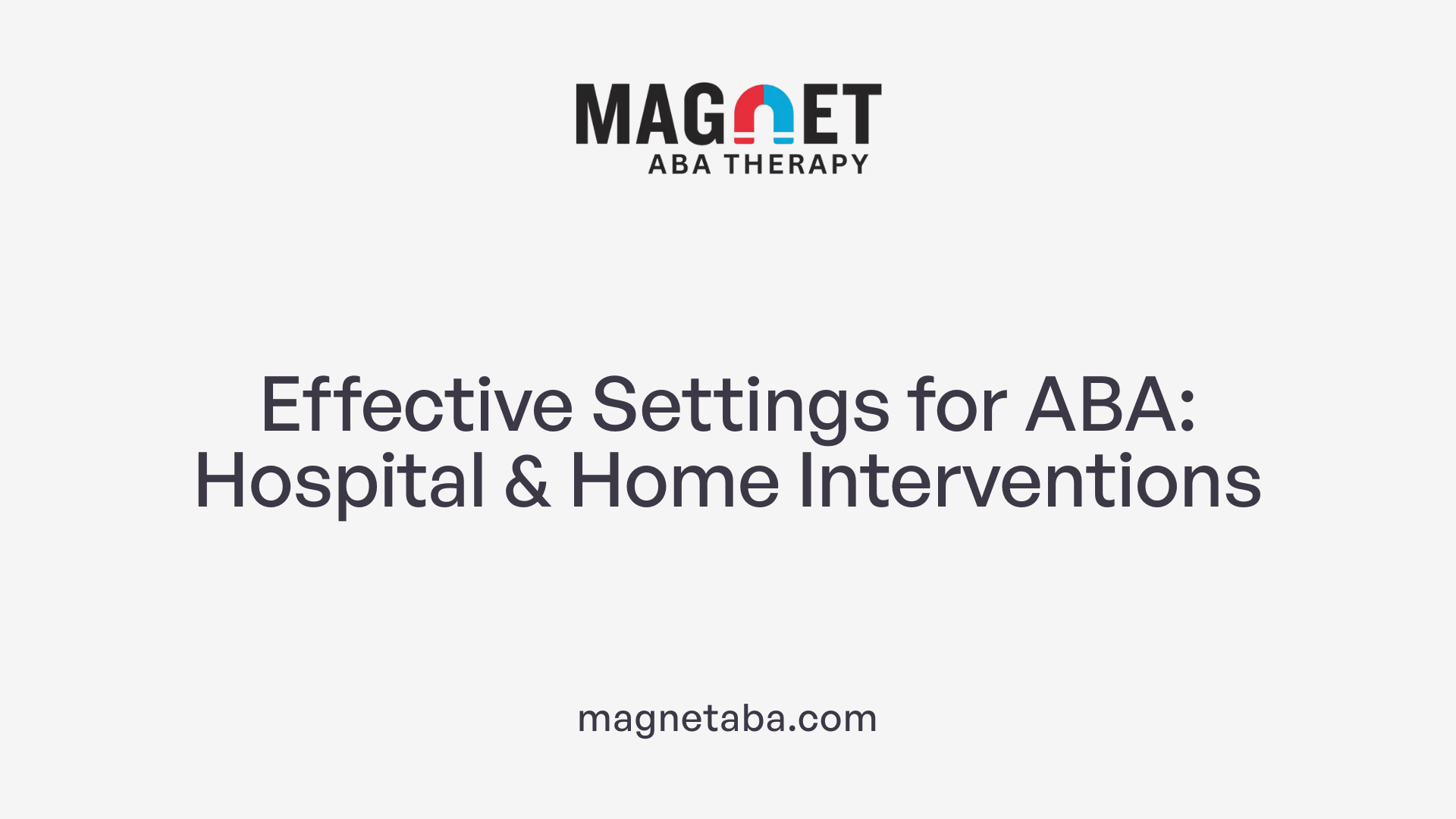Understanding the Role of ABA in Managing Anxiety and Phobias
Applied Behavior Analysis (ABA) therapy stands as a cornerstone intervention for children with autism, particularly in addressing complex challenges like fear and phobias. By combining behavioral science principles with individualized strategies, ABA empowers children to gradually confront and reduce anxiety-provoking stimuli. This article explores key ABA methods such as contact desensitization and positive reinforcement, highlighting how these approaches facilitate meaningful progress and improve quality of life for autistic children facing fear-related obstacles.
What is ABA Therapy and Its Role in Supporting Individuals with Autism?

Definition and overview of ABA therapy
Applied Behavior Analysis (ABA) is a scientifically supported behavioral intervention used to assist individuals with autism. It focuses on understanding how behavior is influenced by environmental factors and applying strategies like positive reinforcement to encourage beneficial behaviors while reducing those that are problematic.
Individualized treatment approach
ABA therapy is tailored to the unique needs of each individual. Treatment plans consider personal goals such as communication, social interaction, self-care, and academic skills. These plans are flexible and regularly adjusted through ongoing assessment and family involvement.
Settings where ABA is delivered
ABA can be provided in various environments, including the child's home, school, or community settings. Home-based ABA offers the advantage of familiar surroundings, making it easier to address specific anxiety triggers and support generalization of learned skills.
Key goals of ABA for autism
The primary objectives are to build functional skills, decrease challenging behaviors, and promote emotional regulation. Techniques like systematic desensitization, positive reinforcement, and graduated exposure help children develop coping strategies, reduce anxiety, and improve social functioning.
Evidence supporting ABA effectiveness
Research and clinical experience affirm that early, intensive ABA intervention leads to meaningful improvements. For example, interventions utilizing contact desensitization without escape prevention have successfully increased approach behaviors toward feared stimuli in children with autism and specific phobias. These strategies support gradual exposure combined with reinforcement and are effective in reducing anxiety symptoms and enhancing quality of life.
Key Principles and Techniques of ABA Therapy in Managing Anxiety and Phobias

What are the key principles and techniques used in ABA therapy?
Applied Behavior Analysis (ABA) therapy operates on fundamental principles like reinforcement, prompting, shaping, and generalization. A central tenet is analyzing the antecedents and consequences of behaviors—understanding what triggers a behavior and what reinforces it—to effectively modify actions.
Techniques in ABA involve detailed observation and assessment to identify target behaviors. Following this, interventions such as positive reinforcement (rewarding desired behaviors) and prompting (providing cues) are systematically applied. These may be coupled with fading prompts to encourage independent responses. Behavior chaining and modeling are also employed to build complex skillsets.
Systematic Desensitization and Graduated Exposure
One important method for anxiety and phobia management is systematic desensitization, where individuals are gradually exposed to feared stimuli while simultaneously reinforcing approach behaviors. Graduated exposure follows a similar pattern, increasing proximity to feared stimuli in controlled steps. This method is supported by data showing increased approach and proximity behaviors in children with autism and specific phobias.
Role of Functional Analysis
Functional analysis plays a vital role by identifying the purpose behind anxiety-related behaviors, such as escape or avoidance. This understanding allows therapists to replace avoidance with approach responses by making the latter more reinforcing, helping reduce problem behaviors.
Data-Driven Intervention Adjustments
Data collection and ongoing analysis ensure ABA treatments are evidence-based and individualized. In clinical studies, monitoring approach behaviors and parental reports after discharge highlight the lasting success of interventions. Such data allow therapists to adjust plans, maximize positive outcomes, and build lasting coping skills.
In summary, ABA therapy combines scientific methods and behavioral strategies like reinforcement, shaping, systematic desensitization, and functional analysis, all tailored through continuous data evaluation to manage anxiety and phobias effectively.
Contact Desensitization: A Gradual Approach to Fear Reduction

What is Contact Desensitization?
Contact desensitization is a behavioral intervention that aims to reduce fear responses by gradually encouraging approach behaviors towards feared stimuli. This method relies on systematically shaping a child’s reactions through positive reinforcement, rewarding small steps closer to the feared item or situation.
How Does the Gradual Exposure Process Work?
The process involves slowly increasing the child's proximity and interaction with the feared object or environment. Instead of forcing immediate exposure, the child is reinforced for successive approximations—small approach responses—which build confidence and reduce anxiety over time.
Why is Reinforcement Favored Over Escape Prevention?
This approach emphasizes differential reinforcement, where approaching the feared stimulus yields stronger positive reinforcement than escaping or avoiding it. Importantly, sessions allow the child to terminate exposure by leaving if overwhelmed. Allowing termination reduces potential problem behaviors linked to forced exposure, making the therapy less aversive and easier to implement.
How Has This Method Been Applied Clinically?
An example of clinical success involved an 8-year-old boy with autism and specific phobia. Through contact desensitization without escape prevention, the child showed notable improvements in approaching and being closer to his previously feared stimuli. Parents reported maintained improvements after discharge, supporting the intervention's effectiveness and lasting impact.
What Are the Benefits of Allowing Session Termination?
Permitting the child to end a session by leaving diminishes pressure and potential escape-driven behaviors. This flexibility fosters a positive therapeutic environment, encouraging voluntary participation and reducing resistance. Additionally, it makes the intervention more adaptable to different settings and easier for caregivers and therapists to apply consistently.
Positive Reinforcement to Encourage Approach Behaviors Towards Phobic Stimuli

What is the concept of differential reinforcement of approach behaviors?
Differential reinforcement of approach behaviors is a strategy that encourages individuals to engage with feared stimuli rather than avoid them. In this method, approaching the stimulus is reinforced more strongly than escaping from it, gradually reshaping the individual's response to reduce fear.
How does reinforcement empower approach rather than avoidance?
By providing positive reinforcement, such as praise or rewards, when a child moves closer to the feared object or situation, the approach behavior becomes more appealing than avoidance. This gradual shaping strengthens the child’s willingness to face the phobic stimulus, promoting adaptive coping.
What are the maintained improvements post-treatment?
Studies have shown that children treated with this approach sustain increased proximity and approach behaviors to previously feared stimuli even after leaving clinical settings. Parents report continued improvements, indicating lasting benefits from the intervention.
How does this impact reducing problem behaviors linked to escape?
The intervention is designed without enforcing escape prevention, meaning the child can opt to leave sessions. This flexibility reduces frustration and the likelihood of problem behaviors associated with attempts to avoid or escape, making the therapy easier to implement and more child-friendly.
How is positive reinforcement used in fear reduction?
Positive reinforcement serves as a motivating factor that rewards approach behaviors toward phobic stimuli. In autism therapy, this reinforcement helps diminish fear responses by associating the previously feared object or situation with positive experiences, facilitating desensitization and emotional regulation.
Hospital-Based and Home-Based ABA Interventions for Specific Phobias

Effectiveness and rapid results in hospital settings
Hospital-based ABA interventions have shown to be effective and can produce rapid improvements when treating specific phobias in children with developmental disabilities such as autism. These interventions utilize methods like contact desensitization without escape prevention, enabling children to gradually approach feared stimuli while maintaining the option to leave sessions, which helps minimize problem behaviors.
Benefits of home-based therapy environment
Home-based ABA therapy offers unique advantages by providing treatment in a familiar environment. This setting increases the child's comfort level and security, which can lead to better engagement and reduced anxiety. Tailoring therapy to home-specific triggers allows for more precise intervention, aligning with the child's daily routines and natural surroundings.
Tailoring interventions to individual triggers
ABA therapy plans are individualized, focusing on identifying and managing each child's specific anxiety triggers. Techniques such as systematic desensitization, positive reinforcement, and graduated exposure are adapted to suit unique needs, ensuring that approach behaviors toward feared stimuli are encouraged effectively. This personalization is vital for fostering success in reducing phobic responses.
Family involvement and collaboration with professionals
Involving families and professionals like behavior therapists is crucial for the success of ABA interventions. Collaboration ensures that strategies are reinforced across environments, and treatment plans are continuously assessed and updated. Family participation helps maintain gains outside formal therapy settings, supporting generalization and long-term maintenance of improved approach behaviors.
Reduced problem behavior through familiar settings
Providing therapy in familiar settings, such as the home or consistent hospital environment, helps decrease problem behaviors often linked with anxiety and escape attempts. The ability to terminate sessions by leaving in hospital interventions and the comfort of home in in-home therapies work together to reduce distress, making it easier to shape approach behaviors and manage anxiety effectively.
Teaching Coping Strategies and Anxiety Management through ABA
What coping skills does ABA teach to children with autism?
ABA therapy equips children with essential coping skills such as deep breathing exercises, progressive muscle relaxation, and guided imagery. These techniques help children regulate their emotions and reduce anxiety by promoting calmness during stressful situations.
How are social stories and visual supports used in ABA for anxiety management?
Social stories and visual supports like emotion charts and timers are integral in helping children understand social contexts and manage anxiety triggers. These tools provide clear, concrete information that aids children in anticipating and adapting to changes or challenging scenarios.
What strategies does ABA use to manage routines and transitions?
Structured and predictable routines are established using visual schedules and consistent daily activities. During transitions, techniques such as countdowns or verbal cues prepare children for upcoming changes, effectively reducing anxiety associated with unpredictability.
How do visual schedules, emotion charts, and timers support anxiety reduction?
Visual schedules offer a roadmap of the day’s events, decreasing uncertainty. Emotion charts help children identify and express their feelings, fostering emotional awareness. Timers can signal the duration of activities or waiting periods, enhancing a child's sense of control.
In what ways does ABA help build adaptive behaviors and emotional regulation?
Through positive reinforcement, ABA encourages adaptive behaviors and emotional regulation by teaching children how to respond to anxiety-provoking situations with coping strategies. These learned behaviors contribute to decreased anxious responses and improved emotional well-being.
Measuring Progress and Adapting ABA Treatment Plans
How Does ABA Therapy Measure Progress in Individuals with Autism?
ABA therapy relies on systematic data collection and detailed monitoring of specific behaviors to evaluate progress. Therapists observe and record measurable actions such as communication attempts, social approaches, and adaptive responses. This data-driven approach highlights improvements, including increased independence and the ability to generalize learned skills across various environments.
Data Collection and Behavior Tracking
Continuous tracking involves recording frequency, duration, and intensity of targeted behaviors. Visual tools like charts or graphs often represent this information, making trends easy to interpret over time. Such precise documentation ensures changes are clearly visible and helps identify areas that require further focus.
Evaluating Improvements in Approach and Adaptive Skills
For children with autism, improvements might include enhanced approach behaviors toward previously feared stimuli, better emotional regulation, or the development of coping strategies. These observable milestones signal therapeutic gains and are central to adjusting ongoing intervention strategies.
Role of Caregiver Feedback
Parents and caregivers offer invaluable insights into how skills transfer beyond therapy sessions. Their observations help confirm sustained progress or alert therapists to possible regressions, fostering a collaborative environment for monitoring effectiveness.
Adjusting Interventions When Progress Plateaus
If data indicates stagnation or decline, treatment plans undergo thorough reassessment. Therapists may introduce new techniques, modify reinforcement strategies, or increase support levels. This flexibility ensures that interventions remain personalized and effective.
Ensuring Individualized and Effective Treatment
ABA therapy emphasizes tailoring approaches to each child's needs, strengths, and challenges. Regular data reviews, combined with caregiver input and professional expertise, enable ongoing adjustments that optimize therapeutic outcomes and promote lasting improvements.
Who Provides ABA Therapy and Their Qualifications
Who Typically Provides ABA Therapy and What Qualifications Do They Have?
ABA therapy is usually provided by a range of professionals trained in behavioral interventions. These include Board Certified Behavior Analysts (BCBAs), ABA therapists, and trained technicians.
Educational and Certification Requirements
To become an ABA therapist, individuals generally start with a bachelor's degree in areas such as psychology, education, or sociology. Many then pursue a master's degree in applied behavior analysis or a related discipline. Certification as a BCBA requires completion of supervised fieldwork, often between 1,500 and 2,000 hours, along with passing a rigorous examination.
Importance of Supervised Fieldwork and Licensure
Hands-on experience gained through supervised fieldwork is crucial for developing practical skills. Licensure and BCBA certification ensure that therapists meet professional standards and are competent in the assessment and treatment of behavioral concerns.
Skills Crucial for Effective Therapy
Successful therapists possess abilities like active listening, adaptability to individual client needs, and strong attention to detail. These contribute to delivering personalized, effective interventions.
Ensuring Quality Through Professional Standards
Maintaining high professional standards through ongoing education, certification, and adherence to ethical guidelines supports quality service and positive outcomes in ABA therapy.
Benefits and Limitations of ABA Therapy for Treating Fear and Anxiety in Autism
What are the benefits and limitations of ABA therapy in autism treatment?
Applied Behavior Analysis (ABA) therapy offers several positive outcomes for children with autism, especially in managing fear and anxiety. Through methods like contact desensitization and positive reinforcement, ABA effectively increases approach behaviors toward feared stimuli and reduces anxiety symptoms. These improvements often extend to better social skills, communication, and adaptive functioning, fostering greater independence and emotional well-being.
Evidence supports ABA's use for anxiety reduction, with studies showing rapid and sustained improvements. Individualized plans, family involvement, and professional collaboration enhance the therapy's effectiveness. Techniques such as gradual exposure, coping strategy training (e.g., deep breathing and relaxation), and structured routines help children manage anxiety in various settings, including home and hospital environments.
However, ABA therapy also presents challenges. It requires significant time commitment and access to qualified therapists can be limited. Some critics express concerns about possible emotional suppression or discomfort caused by intensive behavioral interventions. Costs can be high, and not all children respond uniformly to ABA techniques.
Balancing these factors, ABA remains a widely endorsed and evidence-based approach. Its ability to tailor interventions to individual needs, promote positive behaviors, and reduce anxiety symptoms often outweigh its limitations. Ongoing research and adaptation ensure ABA continues to evolve, addressing concerns while maximizing benefits for children with autism.
The Future of ABA in Addressing Fear and Phobias in Autism
ABA therapy represents a powerful and scientifically grounded approach to addressing fear and phobias in children with autism. Through methods such as contact desensitization and positive reinforcement, therapists can guide children toward gradually confronting and overcoming anxiety-provoking stimuli. The individualized nature of ABA, combined with continuous progress measurement and collaboration among professionals and families, ensures tailored and effective treatment. While challenges exist, including therapy accessibility and commitment requirements, the robust evidence base underscores ABA’s significant potential. As research and clinical practice advance, ABA strategies will continue to evolve, offering even greater hope for improved emotional wellbeing and quality of life for individuals with autism facing fear and phobias.
References
- Shaping Approach Responses as Intervention for Specific ...
- ABA Therapy And Anxiety: What You Need to Know
- Effective Strategies for Managing Anxiety in Children with ...
- How to Become an ABA Therapist - School of Education
- How to Become an Applied Behavior Analyst (ABA) Therapist
- Applied Behavior Analysis (ABA)
- Applied Behavior Analysis (ABA)












